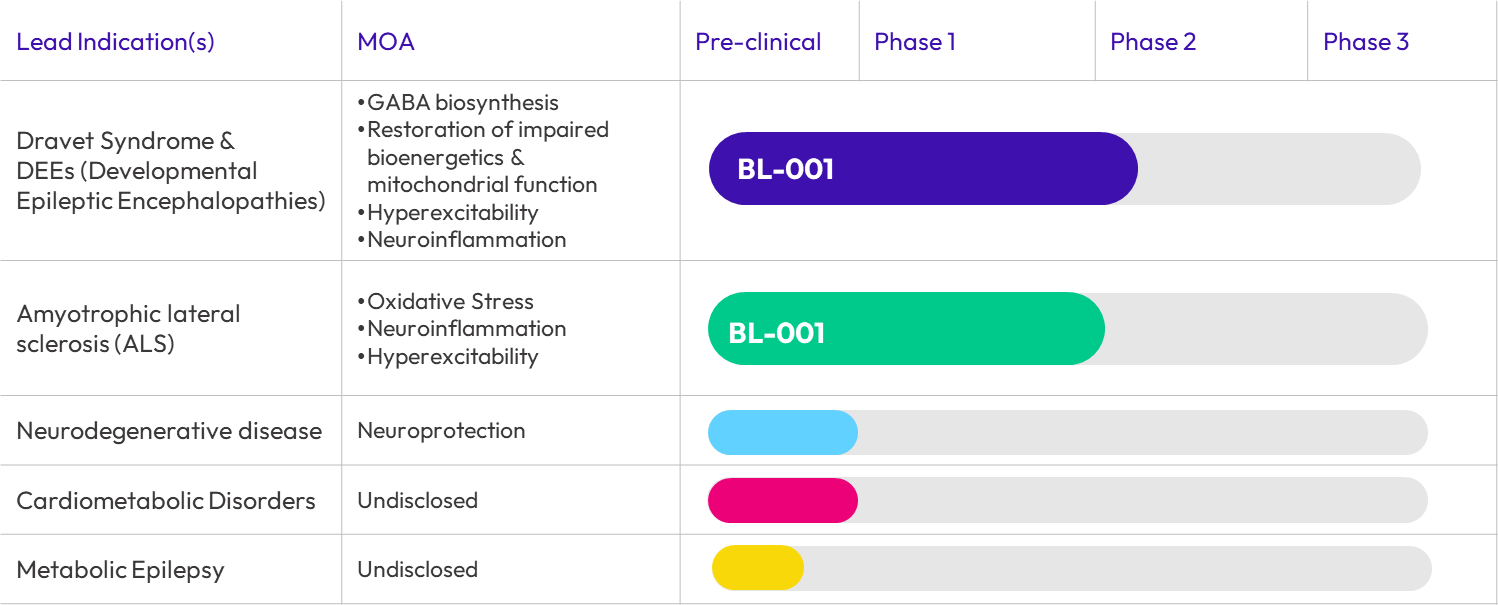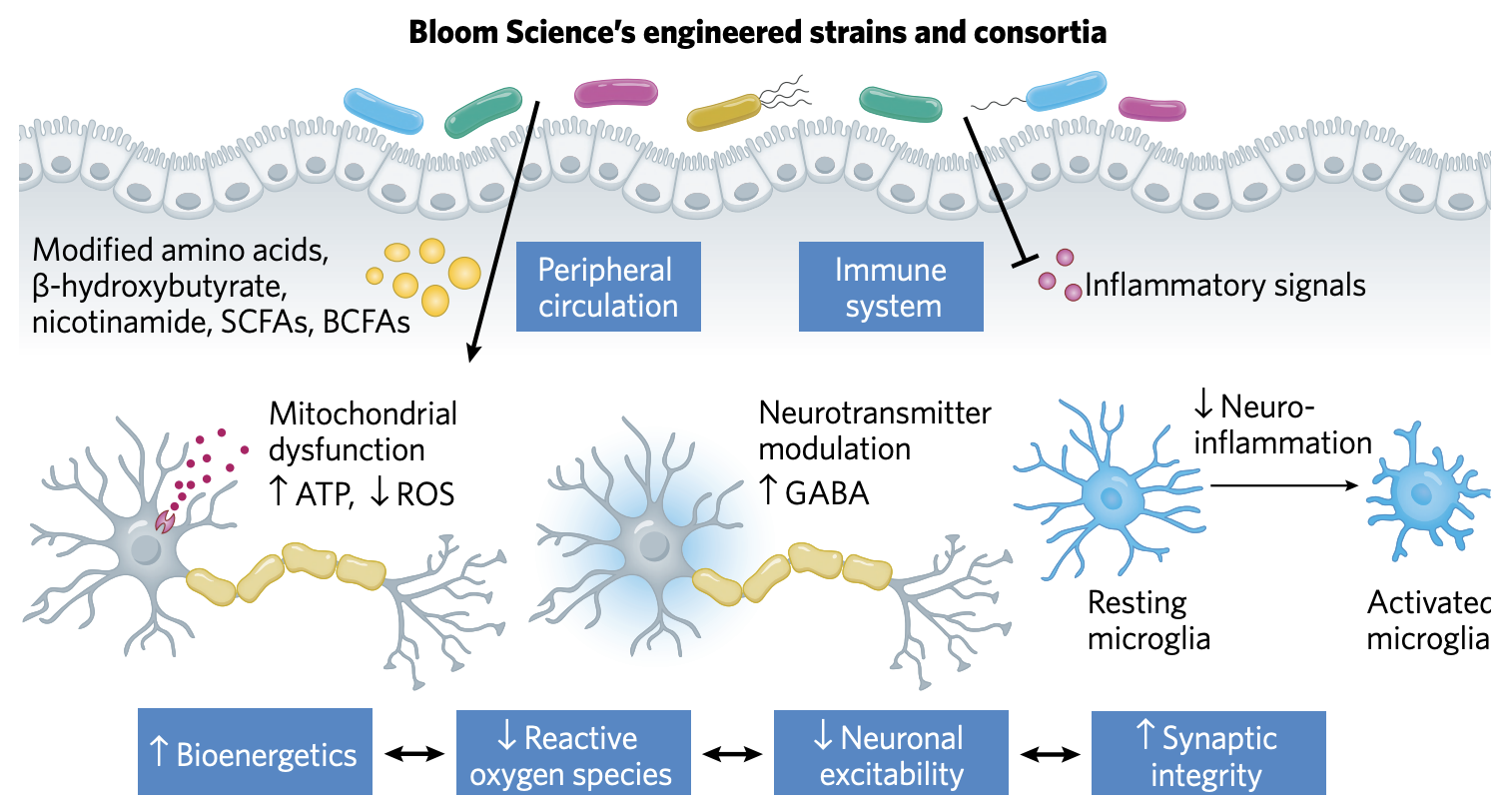Our Science
Targeting the Gut-Brain Axis
Our differentiated approach: Combining microbial genetics with our understanding of neurobiology, immunology and metabolism
Our bodies are home to trillions of microbes that play a vital role in our health. The gut microbiome refers to the complex community of microorganisms that reside in the human gastrointestinal tract. Research continues to evolve, further enhancing our understanding of the role that the gut microbiome plays in the communication between the gut and the brain, known as the Gut-Brain Axis.
The Gut-Brain Axis is a multi-directional signaling network between the microbiota – the community of microorganisms living in the gastrointestinal tract – the immune system, and the brain. Complex pathways of the resident microbes and host systems interact to drive function in the cognitive and emotional centers in the brain. Microbes modulate neuroinflammation as well as host levels of neuroactive molecules, including neurotransmitters and neuropeptides, that affect complex behaviors, such as social, communicative, emotional, anxiety-like behaviors and appetite control.
Overall, the gut microbiome is increasingly recognized as an important factor in the pathogenesis of many neurological and metabolic disorders. Studies have shown that changes in the gut microbiome can lead to alterations in the immune system, which may contribute to the development of neurological disorders. The gut microbiome can also influence the production and regulation of various hormones, such as cortisol and insulin, which have been linked to neurological disorders such as Alzheimer’s disease. By understanding how the gut microbiome influences the Gut-Brain Axis, Bloom Science is developing new therapeutic approaches for patients with rare and complex neurological and metabolic disorders.
Microbiome therapeutics are multifunctional in nature and can target multiple pathways simultaneously.
IrisRx™: Our Breakthrough, Proprietary Platform
Bloom Science has a therapeutic discovery and development platform called IrisRx™. It helps us develop novel therapies for patients living with neurological diseases.
The IrisRx™ platform unlocks the potential for developing multi-functional therapeutics from the most common cell type in the human body, gut commensal microbes, while also utilizing an expanding proprietary knowledge base to advance therapeutic candidates based on synthetic biology.
Neurological conditions are complex and can have multiple underlying causes. The gut-brain axis is also intimately involved in regulating energy homeostasis, which in turn plays key roles in mediating cardiometabolic mechanisms. By focusing on the multidirectional communication between the gut microbiome and the central nervous system, we have a greater chance of targeting the root causes of the disease through multiple pathways.
Because we start with responder data and reverse engineer into novel microbiota drug candidates, our platform is designed to deliver higher translatability and clinical success.
Bloom is developing transformative medicines and diagnostics for brain-gut microbiome interactions in neurological and metabolic diseases and conditions, including:
- Dravet syndrome and other rare epilepsies
- ALS also known as Lou Gehrig’s disease
- Alzheimer’s
- Autism
- Parkinson’s
- Cardiometabolic Disease


Lead Programs
Dravet Syndrome and Other Rare Developmental and Epileptic Encephalopathies
Bloom’s BL-001, an orally-administered Live Biotherapeutic Product (LBP), is in clinical development to investigate the safety, tolerability and efficacy of BL-001 for the potential treatment of seizures associated with Dravet syndrome and other rare developmental and epileptic encephalopathies (DEEs).
Our preclinical studies have shown that BL-001 possesses strong potential to reduce neuronal hyperexcitability, control seizures and overcome drug-resistance with significantly fewer side effects compared to other drugs on the market.
BL-001 is reverse translated from the positive clinical outcomes associated with the Ketogenic Diet in treating refractory epilepsy. It has the potential to provide patients with the same neurological and seizure relief benefits of the Ketogenic Diet, but in the form of a simple daily oral therapeutic.
BL-001 is designed to replicate the antiepileptic effect of the Ketogenic Diet and has been shown to modulate gamma aminobutyric acid (GABA), a neurotransmitter implicated in various seizure disorders, and other key bioenergetic pathways to suppress hyperexcitability which is a key driver in seizures. BL-001 contains two rationally selected human gut microbes that have been shown in both cell based assays and animal studies to eliminate hyper excitatory activity, increase GABA in the hippocampus and significantly reduce or eliminate both seizure frequency and duration.
BL-001 is under investigation and has not been approved by the FDA. More information about the Phase 1 trial is available at clinicaltrials.gov (NCT05818306).
Amyotrophic Lateral Sclerosis (ALS)
Bloom is also using its novel approach to develop treatments for patients with ALS, a disease that causes nerve cells to die, which breaks the neural pathways, and causes extreme mobility loss over time. This disease can develop at any time, but is more common in people over 60 years old.
The evidence suggests that oxidative stress and hyper-excitation are a critical factors in the progression of ALS, leading to the loss of motor neurons and mitochondrial dysfunction. BL-001 aims to address the underlying oxidative stress to potentially slow or halt disease progression while also targeting hyperexcitation. Nicotinamide, an important NAD+ pathway metabolite and a derivative of vitamin B3, can counter the effects of ALS. Bloom has shown BL-001 component strains attenuates motor-neuron loss, and increases lifespan and motor coordination, in ALS model mice.
BL-001 is in development, and has not been approved by the FDA.
Building on the Platform
Bloom’s programs have the potential to address major unmet medical needs and lay the groundwork for second-generation candidates that will benefit from Bloom’s explorations of how to enhance the endogenous functions and properties of bacteria.
Our focus on engineering commensal bacterial consortia and strains found in the mucosal layer of the gut gives us advantages over other synthetic-biology startups and creates drug candidates with superior efficacy, safety and drug-like properties.
Broad Pipeline of Product Candidates

Advancing multiple novel pipeline candidates in rare neuro, neuro-inflammation and cardiometabolic diseases


